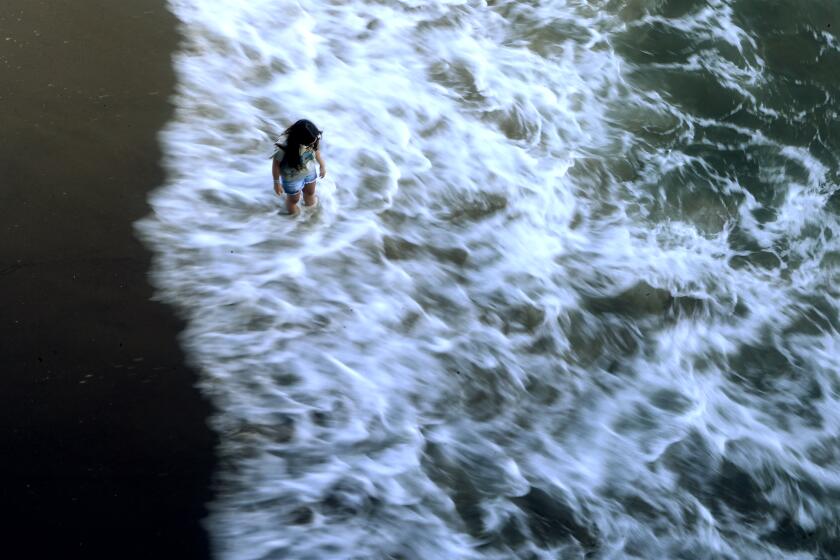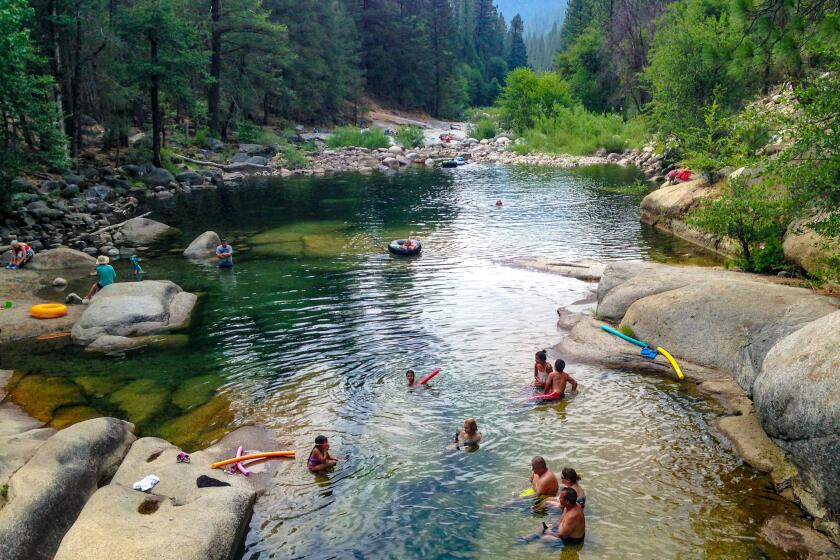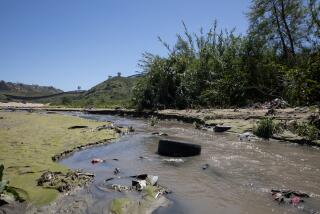Considering visiting L.A. County swimming holes this summer? You may want to avoid these
When considering a nearby swimming hole this summer, water scientists recommend that Los Angeles County residents first check the latest river report card before taking a dip.
While freshwater recreation sites across L.A. have seen improvements in recent years, scientists with the environmental nonprofit Heal the Bay note there’s still a lot of work to be done to limit waterway pollution.
Last summer, almost one-fifth of the 35 analyzed sites in L.A. County posed a high risk to human health, according to the group’s fifth annual river report. About 65% tested in the “green” range — considered healthy for swimmers — and about 15% were in moderate health risk category.
“While it’s encouraging to see that freshwater recreation sites have clean water quality a majority of the time, there’s a long way to go, considering that ocean beaches have good water quality 95% of the time,” said Luke Ginger, a water quality scientist with Heal the Bay, a Los Angeles environmental nonprofit that focused on clean waterways.
The river report card was released Wednesday along with the group’s beach report card, which highlights the coastlines with the dirtiest — and cleanest — waters.
Heal the Bay’s annual report card ranks the state’s dirtiest — and cleanest — beaches based on water-quality analyses. Two from L.A. County made the ‘beach bummer’ list.
From Memorial Day to Labor Day 2022, Heal the Bay scientists tested waterways and used data from other monitoring programs and government agencies to rank water quality in some recreation areas, measuring the presence of fecal indicator bacteria pollution.
“The lower reaches of the Los Angeles River tend to have much higher concentrations of bacteria compared to the upper reaches of the river,” Ginger said. He hopes more research can address this, but he said the reason likely lies with the diminished habitat and greenspace as the river runs through more urban areas downstream.
Here are L.A. County’s 10 worst sites for water quality, deemed the “freshwater fails.” The first three locations are tied for worst after testing every week over the summer in the worst category for health.
The dirtiest freshwater areas in L.A. County
1. L.A. River at Riverfront Park
2. Compton Creek (tied for first)
3. Tujunga Wash at Hansen Dam (tied for first)
4. L.A. River below the Rio Dondo Confluence
5. L.A. River at Willow Street
6. L.A. River at Hollydale Park
7. L.A. River below the Compton Creek Confluence
8. Bull Creek
9. Lake Balboa Boat Ramp
10. Las Virgenes Creek
Each location is part of the L.A. River Watershed, except for No. 10, which is in the Malibu Creek watershed, the report said.
“Most of these sites are in developed areas and receive high amounts of urban runoff,” Ginger said. “Six of the 10 freshwater fails are in the lower L.A. River, south of downtown L.A.”
Cool off while surrounded by the state’s natural beauty.
The cleanest watering holes, considered on the “Honor Roll,” had an eight-way tie for first place after testing in the healthiest category every week last summer, the report said. They are: San Gabriel River Upper Cattle Canyon; San Gabriel River East Fork at Graveyard Canyon; Hansen Dam Lake; San Gabriel River Upper West Fork and Upper East Fork and Lower West Fork; Big Tijunga Creek at Vogel Flatts; and Delta Flats.
The last two locations on the healthiest Top 10 list were Eaton Canyon and San Gabriel River Upper North Fork.
Six of the 10 honor roll sites are in the upper San Gabriel River in the Angeles National Forest, which is also home to Big Tujunga Creek and Eaton Canyon. Hansen Dam Lake was the only honor role site not in the mountains.
“Our goal is to highlight water quality concerns, advocate for water quality improvements and equip community members with the information they need to keep themselves safe and healthy when out enjoying their local swimming hole,” the report said. Heal the Bay officials recommend that people avoid water contact at least three days after a significant rain.
“The biggest driver of poor water quality in our waterways is runoff,” said Tracy Quinn, president and chief executive of Heal the Bay. While the excessive rain this winter wasn’t accounted for in this river report — it only focused on the summer months — she said it’s important to plan for these extremes moving forward.
“Capturing stormwater at any scale can help us to reduce the pollution reaching our rivers, lakes and ocean,” Quinn said.
More to Read
Sign up for Essential California
The most important California stories and recommendations in your inbox every morning.
You may occasionally receive promotional content from the Los Angeles Times.













